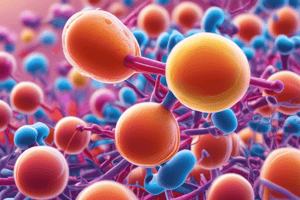Podcast
Questions and Answers
Which of these is a potential adverse effect associated with vancomycin?
Which of these is a potential adverse effect associated with vancomycin?
- Prolonged QT interval (correct)
- Pseudomembranous colitis
- Hepatic dysfunction
- Superinfections
Which adverse effect of macrolides is also a potential concern with vancomycin?
Which adverse effect of macrolides is also a potential concern with vancomycin?
- Superinfections
- Prolonged QT interval (correct)
- Hepatic dysfunction
- Pseudomembranous colitis
What common adverse effect is shared by both vancomycin and macrolides?
What common adverse effect is shared by both vancomycin and macrolides?
- Redman syndrome
- Renal dysfunction
- GI effects (correct)
- CNS effects
What adverse effect of vancomycin is linked to its potential impact on renal function?
What adverse effect of vancomycin is linked to its potential impact on renal function?
What adverse effect of macrolides could potentially be a concern for patients with pre-existing cardiac conditions?
What adverse effect of macrolides could potentially be a concern for patients with pre-existing cardiac conditions?
Which of these is a potential adverse effect that's specific to macrolides and not vancomycin?
Which of these is a potential adverse effect that's specific to macrolides and not vancomycin?
Which of these adverse effects is associated with both macrolides and vancomycin but potentially signifies a more serious concern for patients with pre-existing conditions?
Which of these adverse effects is associated with both macrolides and vancomycin but potentially signifies a more serious concern for patients with pre-existing conditions?
What adverse effect associated with macrolides could contribute to secondary infections?
What adverse effect associated with macrolides could contribute to secondary infections?
Which of the following is a common adverse effect of sulfonamides?
Which of the following is a common adverse effect of sulfonamides?
Which of the following is a reason why ciprofloxacin is often given with clavulanic acid or sulbactam?
Which of the following is a reason why ciprofloxacin is often given with clavulanic acid or sulbactam?
What is the mechanism of action of the combination of trimethoprim and sulfamethoxazole (Bactrim)?
What is the mechanism of action of the combination of trimethoprim and sulfamethoxazole (Bactrim)?
Which of the following is a serious adverse effect that requires immediate discontinuation of sulfonamide therapy?
Which of the following is a serious adverse effect that requires immediate discontinuation of sulfonamide therapy?
Which of the following enzymes is specifically inhibited by trimethoprim in the combination of trimethoprim and sulfamethoxazole?
Which of the following enzymes is specifically inhibited by trimethoprim in the combination of trimethoprim and sulfamethoxazole?
Which of the following adverse effects associated with sulfonamides can potentially lead to kidney stones?
Which of the following adverse effects associated with sulfonamides can potentially lead to kidney stones?
Which of the following is a reason for caution when administering ciprofloxacin to patients with a history of seizure disorders?
Which of the following is a reason for caution when administering ciprofloxacin to patients with a history of seizure disorders?
Which of the following is a key nursing consideration for patients receiving sulfonamides?
Which of the following is a key nursing consideration for patients receiving sulfonamides?
Which of the following adverse effects is associated with both tetracycline and lincosamide antibiotics?
Which of the following adverse effects is associated with both tetracycline and lincosamide antibiotics?
What is a potential life-threatening adverse effect associated with the use of lincosamides?
What is a potential life-threatening adverse effect associated with the use of lincosamides?
Which of the following is a potential adverse effect of tetracycline that is specifically concerning for pediatric patients?
Which of the following is a potential adverse effect of tetracycline that is specifically concerning for pediatric patients?
A patient experiencing severe nausea and vomiting after starting a lincosamide antibiotic should be monitored for what potential complication?
A patient experiencing severe nausea and vomiting after starting a lincosamide antibiotic should be monitored for what potential complication?
Why is it important for healthcare providers to monitor patients receiving lincosamide antibiotics for clinical signs of bone marrow suppression?
Why is it important for healthcare providers to monitor patients receiving lincosamide antibiotics for clinical signs of bone marrow suppression?
Which of the following nursing considerations is MOST pertinent for a patient receiving tetracycline therapy?
Which of the following nursing considerations is MOST pertinent for a patient receiving tetracycline therapy?
Which of the following describes the mechanism of action for lincosamides that allows them to be effective against certain bacteria?
Which of the following describes the mechanism of action for lincosamides that allows them to be effective against certain bacteria?
Which of the following is a class of antibiotics that is frequently used as an alternative to penicillin when it is contraindicated?
Which of the following is a class of antibiotics that is frequently used as an alternative to penicillin when it is contraindicated?
Flashcards
Ciprofloxacin
Ciprofloxacin
An antibiotic with broad spectrum coverage, can be bactericidal or bacteriostatic depending on dose.
Indications for Ciprofloxacin
Indications for Ciprofloxacin
Used for moderate to serious infections like urinary, respiratory tract, and skin infections.
Caution with Ciprofloxacin
Caution with Ciprofloxacin
Avoid in children and caution with renal, hepatic dysfunctions, and seizure disorders.
Resistance to Ciprofloxacin
Resistance to Ciprofloxacin
Signup and view all the flashcards
Sulfonamides
Sulfonamides
Signup and view all the flashcards
Indications for Sulfonamides
Indications for Sulfonamides
Signup and view all the flashcards
Cautions with Sulfonamides
Cautions with Sulfonamides
Signup and view all the flashcards
Pairing with Trimethoprim
Pairing with Trimethoprim
Signup and view all the flashcards
Tetracycline
Tetracycline
Signup and view all the flashcards
Adverse effects of Tetracycline
Adverse effects of Tetracycline
Signup and view all the flashcards
Indications for Tetracycline
Indications for Tetracycline
Signup and view all the flashcards
Lincosamides
Lincosamides
Signup and view all the flashcards
Adverse effects of Lincosamides
Adverse effects of Lincosamides
Signup and view all the flashcards
MRSA Infection
MRSA Infection
Signup and view all the flashcards
Contraindications for Tetracycline
Contraindications for Tetracycline
Signup and view all the flashcards
Nursing considerations for Lincosamides
Nursing considerations for Lincosamides
Signup and view all the flashcards
Vancomycin
Vancomycin
Signup and view all the flashcards
Indications for Vancomycin
Indications for Vancomycin
Signup and view all the flashcards
Contraindications for Vancomycin
Contraindications for Vancomycin
Signup and view all the flashcards
Key adverse effects of Vancomycin
Key adverse effects of Vancomycin
Signup and view all the flashcards
Macrolides
Macrolides
Signup and view all the flashcards
Indications for Macrolides
Indications for Macrolides
Signup and view all the flashcards
Key adverse effects of Macrolides
Key adverse effects of Macrolides
Signup and view all the flashcards
Nursing considerations for Vancomycin & Macrolides
Nursing considerations for Vancomycin & Macrolides
Signup and view all the flashcards
Study Notes
Antimicrobials
- Bactericidal: Kills bacteria, disrupting cell membrane/wall stability or essential proteins/enzymes.
- Bacteriostatic: Prevents bacterial replication, often by obstructing essential protein/enzyme systems involved in reproduction.
- Prophylaxis: Prevents infection before it occurs, typically for high-risk patients.
- Resistance: Pathogens adapt over time to become less susceptible to anti-infectives.
- Spectrum: Range of bacteria an antibiotic effectively targets; broad spectrum (wide range) or narrow spectrum (specific types).
- Superinfection: Opportunistic pathogens proliferate due to destruction of normal flora by antibiotics.
Mode of Action of Antibiotics
- Cell Wall Synthesis Inhibitors: β-lactams, glycopeptides, fosfomycin, bacitracin, vancomycin.
- Cell Membrane Synthesis Disruptors: Lipopeptides, polymyxins.
- Folate Synthesis Inhibitors: Sulfonamides.
- Protein Synthesis Inhibitors: Tetracyclines, aminoglycosides, macrolides, lincosamides , oxazolidinones.
- DNA Synthesis Inhibitors: Quinolones, Fluoroquinolones.
- RNA Synthesis Inhibitors: Rifampicin, ansamycins.
Bactericidal vs. Bacteriostatic
- Bactericidal: Irreversible, kills the bacteria directly, inhibits cell wall formation. Requires no immune response to destroy bacteria.
- Bacteriostatic: Reversible, prevents bacteria from reproducing. Relies on the host's immune system to eliminate the bacteria, inhibits DNA replication/protein synthesis.
- MBC: Minimum Bactericidal Concentration - drug concentration that eliminates 99.99% of bacteria.
- MIC: Minimum Inhibitory Concentration - drug concentration that inhibits bacterial growth.
Antibiotic Resistance
- Restriction of antibiotic access: Bacteria make changes or limits of entry points into cells.
- Antibiotic elimination: Bacteria pump antibiotics out of cells.
- Antibiotic modification: Enzymes (breaking down the antibiotic).
- Target alteration: Bacteria modify the target's structure, antibiotic can't bind anymore.
- Antibiotic bypass: Bacteria find and utilize alternative pathways.
Core Elements of Antibiotic Stewardship
- Prescribing antibiotics when truly needed.
- Prescribing appropriate antibiotics, with adequate dosages.
- Using the shortest duration of antibiotics based on available evidence.
- Using culture results to reassess the treatment.
Gram Stains of Bacteria
- Gram-positive: Thicker cell walls, stain purple.
- Gram-negative: Outer membrane, thinner cell walls, stain pink.
Nursing Considerations for Antibiotic Therapy
- Infection site and type of organisms.
- Determine the antibiotic spectrum.
- Consider the patient's health status.
- Antibiotic choice, common and dangerous side effects, contraindications, monitoring labs.
- Monitor for superinfections, renal function (e.g., urine output and kidney labs, etc.), hydration status.
Culture and Sensitivity Report
- Important Data (from report): Collected date & time, source (e.g., urine, blood), estimated pathogen concentration
- Organism Identification: Bacteria type or name
- Anitbiotic susceptibilities: Results of testing different antibiotics to evaluate if bacteria is sensitive or resistant to the antibiotic.
- Interpretation: Determine if bacteria is susceptible (S), intermediate (I), resistant (R). Focus on selecting the lowest MIC (minimum inhibitory concentration) of available antibiotics.
Antibiotic Drug Families
- Aminoglycosides: Often used against gram-negative bacteria. Can cause hearing loss / kidney damage.
- Carbapenems: Broad-spectrum, often used for severe infections; use with caution in patients with seizure disorders.
- Cephalosporins: Vary widely in their spectrum (first-generations effective gram +, later generations more gram -)
- Fluoroquinolones: Broad-spectrum, can affect the musculoskeletal system.
- Penicillins: Often for bacterial infections; allergy is very common, causing anaphylaxis.
- Sulfonamides: Broad spectrum, typically for urinary tract infections and skin infections.
- Tetracyclines: Broad-spectrum, but use should be avoided in children as it affects bone/teeth development
- Lincosamides: Often for skin, bone, or respiratory infections; can trigger Clostridium difficile colitis.
- Lipoglycopeptides (e.g., vancomycin): Primarily used against gram-positive bacteria, including MRSA.
- Macrolides: Broad spectrum, effective in people who are allergic to penicillin. Can cause severe stomach issues and interactions with other medications.
- Antiseptics: (e.g., nitrofurantoin): Often used for urinary tract infections; broad spectrum.
Nursing Considerations for Antibiotic Adminstration
- Monitor for adverse reactions such as allergic reactions, kidney or liver problems. Always assess for drug interactions with other medications the patient may be taking.
- Patient education: Instruct patient about side effects, to avoid unnecessary use and importance of finishing the entire medication course to avoid antibiotic resistance.
Studying That Suits You
Use AI to generate personalized quizzes and flashcards to suit your learning preferences.




